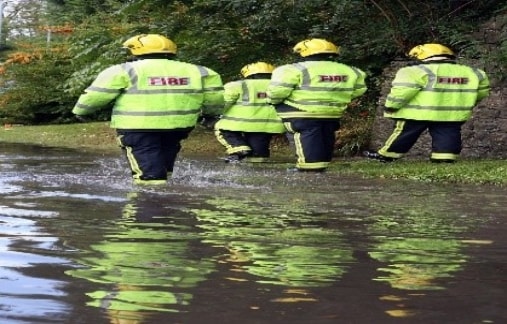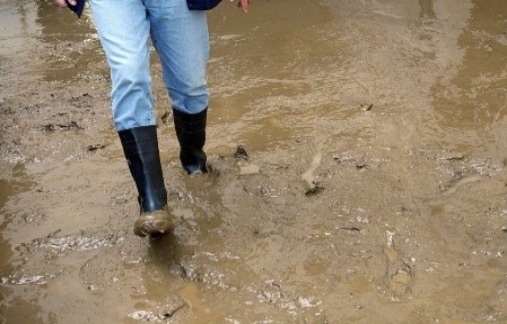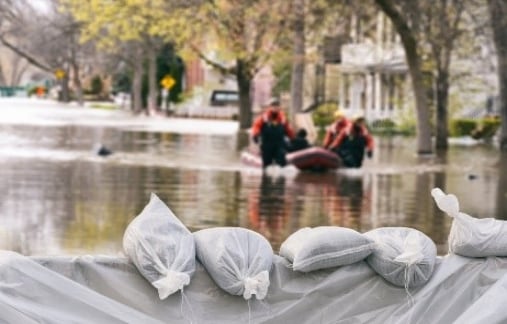Hazard Based Guidelines: Personal Protective Equipment for Workers in Hurricane Flood Response



The purpose of this National Institute for Occupational Safety and Health (NIOSH) fact sheet is to provide general guidance for personal protective equipment (PPE) for workers responding in hurricane flood zones. This guidance will be updated as additional information is available. PPE selection and use is site and task specific. General guidelines must be adapted to specific conditions. This guidance represents professional judgment based on experience from responses to past storms and floods. Additional interim recommendations will be added for clean-up and restoration operations.
These recommendations focus on the following hazards associated with response activities:
- Hazard 1 Sharp jagged debris
- Hazard 2 Floodwater exposure
- Hazard 3 Electrical hazards
- Hazard 4 Contact with blood/body fluids and handling animal and human remains
- Hazard 5 Slick and unstable surfaces
Note: This guidance is not a comprehensive list of hazards and does not include important hazards such as stress or fatigue that are not addressed via PPE.
Disaster sites pose many occupational health and safety concerns. These hazards and exposures are a function of the unstable nature of the site, the potential for worker exposure to unknown hazardous substances and the type of work performed. An accurate assessment of all hazards may not be possible because they may not be immediately obvious or identifiable. Where possible, NIOSH has made default recommendations for PPE that we believe will meet the probable hazards.
For most work in flooded areas, or areas that have been subjected to flooding, response personnel will need the following personal protective equipment: hard hats, goggles or safety glasses, heavy work gloves, watertight boots with steel toe and insole (not just steel shank), and hearing protection where excessive noise from equipment poses a risk of hearing damage. PPE should be provided in a range of sizes to ensure proper fit.
For additional information on what equipment you need for protection against exposure to specific hazards, contact your local OSHA office or consult the NIOSH Pocket Guide to Chemical Hazards.
Workers involved with hurricane or flood response should be aware of the potential dangers involved and the proper safety precautions.
- CDC has developed general guidance for what workers should bring with them to the flood area.
- OSHA has worker safety guidance at the following link.
- NIOSH Publication No. 94-123 identifies several hazards associated with the aftermath of a flood. Because the level of experience will vary among workers, response workers must work together and look out for one another to ensure safety.
Any wounds, cuts, or animal bites should be immediately cleansed with soap and clean water. Familiarity with basic first aid is advised to self-treat any injury until medical attention can be obtained. Additional information resources include:
- Interim Immunization Recommendations for Emergency Responders
- Emergency Wound Care After a Natural Disaster
In addition, response workers are at serious risk for developing heat stress. Excessive exposure to hot environments can cause a variety of heat-related problems, including heat stroke, heat exhaustion, heat cramps, and fainting. The need to use PPE can exacerbate heat exposures. Response workers should be familiar with heat stress symptoms.
- OSHA has a pocket card on heat stress available
- See heat stress topic page for additional NIOSH information.
NIOSH requests your assistance in disseminating this interim document to all workers involved in flood response.
Risks:
Workers handling hurricane related debris may suffer wounds. Tetanus is a potential health threat for persons who sustain wound injuries. Also, any wound has the potential for becoming infected, and floodwater exposures may add to this concern.
General PPE Recommendations:
Use heavy gloves to protect the hands when handling debris to minimize the chances of cuts and scrapes. Gloves designed to protect the skin from chemical exposure are not typically strong enough to protect from debris. Multiple layers of gloves (double gloving) may be necessary. Comfortable, form fitting clothing that includes long pants, long sleeve shirts, boots, eye protection (safety glasses, goggles, or faceshields), and protective head covers are also appropriate.
Risks:
Floodwaters may contain bacteria from human and animal wastes. The most likely symptoms from an infection are stomach-ache, fever, vomiting and diarrhea. While skin contact with flood water does not, by itself, pose a serious health risk, emergency response personnel and the public should avoid direct contact with standing water when possible to minimize the chance for infection. Chemical contamination of floodwaters can also occur and contamination levels may be higher nearer to sources such as industrial locations.
Work in and around moving or standing water in flooded areas presents a risk of drowning. Standing or working in water which is cooler than 75 degrees F (24 degrees C) will remove body heat more rapidly than it can be replaced, resulting in hypothermia.
General PPE Recommendations:
Double gloving with a waterproof glove under a heavy work glove is the best way to protect the hands from both cuts and scrapes and floodwater exposure. Boots and rain gear can be used to prevent lower body skin exposures.
It is important to minimize contaminating the inside of the gloves. Gloves not disposed of should be cleaned with soap and water and dried between uses.
Floodwaters are associated with strong odors, but experience in past floods and disease outbreak tracking do not suggest the need for a general recommendation for default respirator use by all personnel. As with all emergency operations, site specific information should be used to tailor recommendations to the hazards and exposures at hand. For example, use of N95 respirators might be advisable adjacent to aerated floodwater where mists are created- such as potential tasks associated with repair of pumping facilities or discharge pipes. CDC will provide additional updates as more information becomes available for specific tasks and locations.
Avoid working alone and wear a Coast Guard-approved life jacket or buoyant work vest when entering flood waters or working over or near flood waters.
Refer to OSHA guidance
For additional information on what equipment you need for protection against chemical exposures, contact your local OSHA office or consult the NIOSH Pocket Guide to Chemical Hazards.
Additional Information:
Wearing wet gloves or PPE can cause dermal irritation. Long exposures to wet conditions can compromise the function of the skin barrier. Repeated use of impermeable gloves, especially in hot and humid conditions, can aggravate skin rashes. Cotton liners are sometimes used under protective gloves to improve comfort and to prevent dermatitis. Latex gloves should be avoided because of the risk of developing skin sensitivity or allergy.
Open wounds and skin conditions such as eczema and psoriasis may increase your risk of infection. Contamination of wounds with water (fresh or sea water) can lead to infections caused by waterborne organisms.
See: emergency wound
If skin contact with floodwaters does occur, CDC strongly advises the use of soap and water to clean exposed areas. Waterless alcohol-based hand rubs can be used when soap or clean water is not available. Hands should be washed after removal of gloves.
There is a wide range of damage, work scenarios, and tasks associated with hurricane response, and exposure assessments are not yet available. Local information should be used to tailor recommendations to the hazards and exposures at hand.
Firefighters and others involved with responding to fires should use appropriate respiratory protection. Post fire clean-up operations occurring at industrial or chemical facilities may warrant use of protective equipment.
As conditions dry out, there is some likelihood that demolition operations may generate dust exposures for construction and restoration workers. It is likely that other special tasks (e.g. welding and cutting) may generate airborne hazards and that respiratory protection will be needed. CDC will provide additional updates as more information becomes available.
Risks:
Electrical, overhead power lines, power junctions, and downed electrical wires and cables can cause electrocution and burns. Fallen lines can also energize other objects such as fences, ladders, or metal building parts. Use of improperly sized or operated portable generators during electrical outages can also cause “backfeed” injuries to workers performing repair work in neighboring buildings. Only trained electricians and utility workers should approach or handle electrical lines. All other response workers should avoid going near all downed lines and should treat them as if energized.
General PPE Recommendations:
Electricians and utility workers need to use special electrically resistant PPE including head covers, gloves, boots, and appropriate eye protection.
Additional information:
Special electrical PPE is only one aspect of electrical safety practice. Special training and practices to test, de-energize, isolate, and/or lockout hazardous energy sources are important. See the NIOSH electrical safety page
OSHA has electrical safety factsheets at:
Working Safely Around Downed Electrical Wires
Working Safely with Electricity
CDC has a factsheet on “backfeed” and power outage safety
Risk:
There is no direct risk of contagion or infectious disease from being near human remains for people who are not directly involved in recovery or other efforts that require handling dead bodies. However, workers who must have direct contact with human remains can have exposure to blood borne pathogens. Blood, bloody fluids, body fluids, and tissues are potential sources of blood-borne infections from pathogens including Hepatitis B, Hepatitis C, and HIV. Exposures to medical providers and responders may occur via a cut or puncture wound; through mucous membranes (eye, nose, mouth); and through non-intact skin (dermatitis/rashes, injuries, abrasions).
General PPE Recommendations:
Workers who will have direct contact with the victims, or surfaces contaminated with blood or body fluids should use universal precautions. These require use of protective barriers such as gloves, face-shields, or protective eyewear.
The CDC has developed interim health recommendations for workers who handle human remains.
Workers who have direct contact with the victims, bodies, or surfaces contaminated with blood or body fluids should use universal precautions identified in the interim CDC recommendations
CDC recommends surgical masks for handling human remains.
Organic vapor respirators can be used for nuisance odor control where needed. One option that provides odor control and universal precaution splash and eye protection is to use a full facepiece respirator with N95 and organic vapor cartridges.
Additional information:
See the NIOSH bloodborne pathogens
CDC recommends N95 particulate respirators for handling swine and poultry animal carcasses
Risk:
Traumatic injuries, including serious fall injuries, from slips, trips and falls, or collapsing materials.
General PPE Recommendations:
Ensure that workers have a full array of PPE, including safety shoes with slip resistant soles, cut resistant gloves, eye protection, and hard hats.
Ensure that workers use full protective equipment and lifelines tied off to suitable anchor points, including bucket trucks, whenever possible.
Additional information:
NIOSH Hazard Based Guidelines: Protective Equipment for Workers in Hurricane Flood Response
